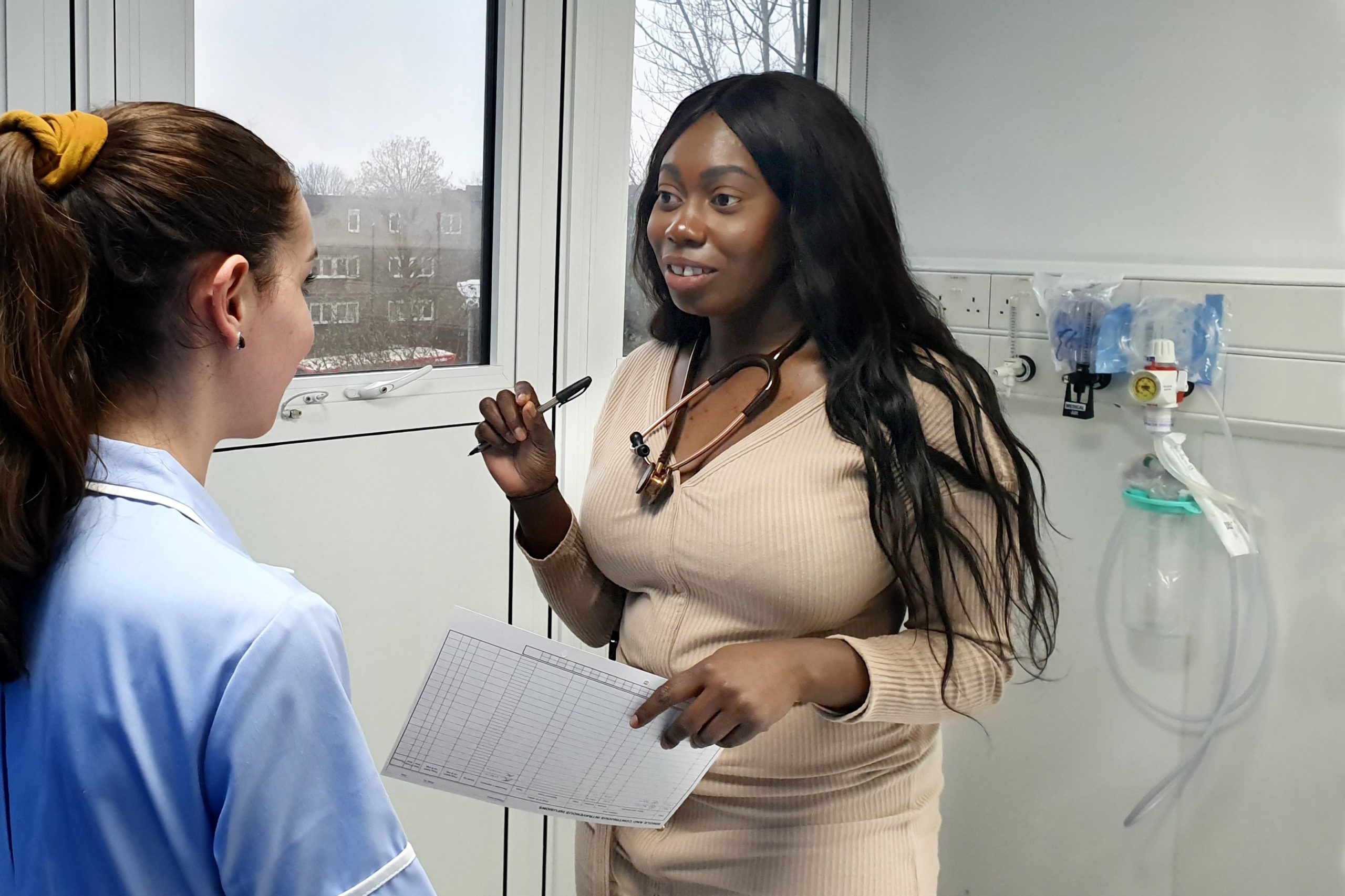
Stephanie Ghartey
As an advanced clinical practitioner (ACP) within the ambulatory emergency care unit at Whittington Hospital in Highgate, north London, I encounter different and complex clinical issues each day.
ACPs are highly trained and experienced registered healthcare professionals who have a greater level of autonomy and clinical decision-making capability. ACPs come from a range of healthcare backgrounds and include pharmacists, nurses, paramedics, physiotherapists, occupational therapists, healthcare scientists and midwives.
08:30 – start
The first thing I do in the morning is review patients over the phone who have previously attended the emergency clinic. This might include a review of symptoms, a discussion about test results and/or future investigations, or completion of any pending referrals.
The rapid response and virtual ward team visits patients in their own home environments to either prevent hospital admission or reduce patients’ length of stay in hospital
My primary functions within the ambulatory emergency care unit involve assessment, examination, diagnosis and treatment of patients who attend the clinic. The aim is to improve the patient experience of hospital healthcare and avoid hospital admission.
09:30
I attend a multidisciplinary team (MDT) meeting with junior doctors, a nurse ACP, the nurse in charge and that day’s lead consultant. We spend around 30 minutes reviewing the upcoming appointments and allocate patients to specific clinicians who are best suited to review them.
On average, I see between six to ten patients per day, depending on the complexity of the cases and the number of same day referrals. We receive referrals from the accident and emergency (A&E) department, GPs, the London Ambulance Service, our rapid response and virtual ward team and the Whittington Hospital inpatient wards.
The rapid response and virtual ward team visits patients in their own home environments to either prevent hospital admission or reduce patients’ length of stay in hospital (i.e. accommodate early discharge).
10:00
My first patient is a young woman, initially seen in A&E. An ultrasound doppler scan of the patient’s left leg has shown a proximal deep vein thrombosis. I take her history and, because this is an unprovoked episode, decide further examination and investigations are needed, including a chest x-ray, urine dipstick and breast examination.
Following my assessment, I conclude there are no red flags for malignancy in this patient. I refer her to our haematology team to be followed up in three months. I then counsel her on her newly prescribed rivaroxaban. This is an area where my pharmacy experience is invaluable, as my medical colleagues are not sufficiently experienced in counselling and will often refer the patient to a pharmacist, causing delays in patient care.
10:30
I review my second thrombosis patient who has had a CT scan of his chest, abdomen and pelvis to assess for underlying malignancy. Unfortunately, the report shows metastases in his liver, lungs, thyroid and pelvis. As part of my work-up for this patient, I liaise with our acute oncology consultant for referral to our cancer of unknown primary cause MDT and make an onward plan for this patient and his family.
I sit down with the patient and his sister to deliver the diagnosis of cancer, which is likely terminal. This conversation is very different from those I had as a ward pharmacist. Although I was involved with complex and unwell patients, I was never responsible for delivering bad news to patients and their families. I have found this a particularly challenging part of my role, but the support I receive from colleagues and consultants is immense and extremely helpful. It helps to know that I am able to speak to other team members if I ever feel overburdened.
At the end of our conversation, I write a prescription for prednisolone and tinzaparin injections. We also discuss potential side effects and his upcoming oncology appointment. This case really affected me, and I still think about the patient to this day.
After the patient leaves, I take a few minutes to recoup my thoughts and document the consultation. I chat to one of my colleagues about the emotional nature of this conversation, before I have to move on and see the next patient on my list.
11:50
I see a new patient who was referred by their GP for a left foot ulcer and cellulitis. He has been previously diagnosed with type 2 diabetes and has a small ulcer on his dorsum with ascending erythema towards his knee.
We discuss his diabetic control and medication adherence, which are both poor. He has not attended his two most recent hospital appointments so was discharged back to his GP. I reiterate the importance of taking his medicines as it will prolong the healing time of the ulcer if his diabetes is poorly managed, and I order an HbA1c test to confirm his poor diabetic control. I prescribe five days of intravenous antibiotics with daily review to ensure an oral switch at an appropriate time.
I refer him to podiatry and the diabetes team again and explain the importance of attending these appointments. This is in keeping with our goals of shared decision making and supporting our patients after discharge.
My skills as an experienced pharmacist complement my work as an advanced clinical practitioner in more ways than I can count
14:00
My consultant asks me to review a patient referred for hypertension monitoring with a blood pressure of 195/105mmHg.
I perform a full assessment, including covering the patient’s drug history, as well as completing a physical examination. This comprises of a cardio-respiratory and cranial nerve examination, including fundoscopy to exclude papilloedema. She does not have any life-threatening symptoms, such as new onset confusion, chest pain, signs of heart failure or acute kidney injury. I ask for an electrocardiogram to be done, which shows left ventricular hypertrophy.
The patient should be taking amlodipine 10mg daily, but I can see she has not collected her prescription for two months — she does not like taking any tablets and did not think they were necessary as she found them ineffective. I sit down with her and discuss the long-term effects of hypertension and the importance of her medication. I explain to her that she may not feel like she has any symptoms of hypertension, but she has a greatly increased risk of stroke, heart failure and kidney disease and we can see some of the effects on her heart already.
I prescribe her immediate amlodipine 10mg and monitor her for a couple of hours until her blood pressure falls to about 165/95mmHg. I strongly advise that she sees her GP as soon as possible, because I suspect an angiotensin receptor blocker will need to be added to her medicines regime. This woman leaves happy and I feel that our conversation was effective and may have a lasting benefit to her health.
16:00
We have another MDT meeting in the late afternoon. We discuss all the patients who have been seen through the day, those who are yet to come into the department and any last minute or late referrals. We also discuss any queries, learning points or interesting cases seen during the day.
My consultant gives me an opportunity to talk about the patient I diagnosed with cancer and offers me some helpful and constructive feedback.
16:30 — finish
Towards the end of the day, I complete any notes and referrals that I haven’t finished.
I spend the final half hour of the day completing work on an audit, which is reviewing patients who have had lower limb ultrasound dopplers and assessing the time taken from clinical suspicion to diagnosis.
My skills as an experienced pharmacist complement my work as an ACP in more ways than I can count. Pharmacy has given me an invaluable skillset which allows me to provide an important and highly rewarding contribution to the ambulatory emergency care unit.
Box: Information for pharmacists interested in a similar role
- As a new area, entry level advanced clinical practitioner (ACP) roles are NHS agenda for change band 7 or potentially 8a;
- Advanced clinical practice is a route for pharmacists who want to expand their scope of practice. ACPs are expected to have experience in a range of hospital, and potentially, community rotations, including medicine, but especially acute medicine, surgery and the intensive therapy unit;
- You must be comfortable dealing with change;
- You need to enjoy learning new things every day. When starting out, you will be going from expert to novice and this can be personally challenging;
- A postgraduate master’s degree in advanced clinical practice is a pre-requisite as advanced clinical practitioners are required to have an expert knowledge base for their expanded scope of practice and demonstrate clinical competence in clinical practice; leadership and management; and education and research.


